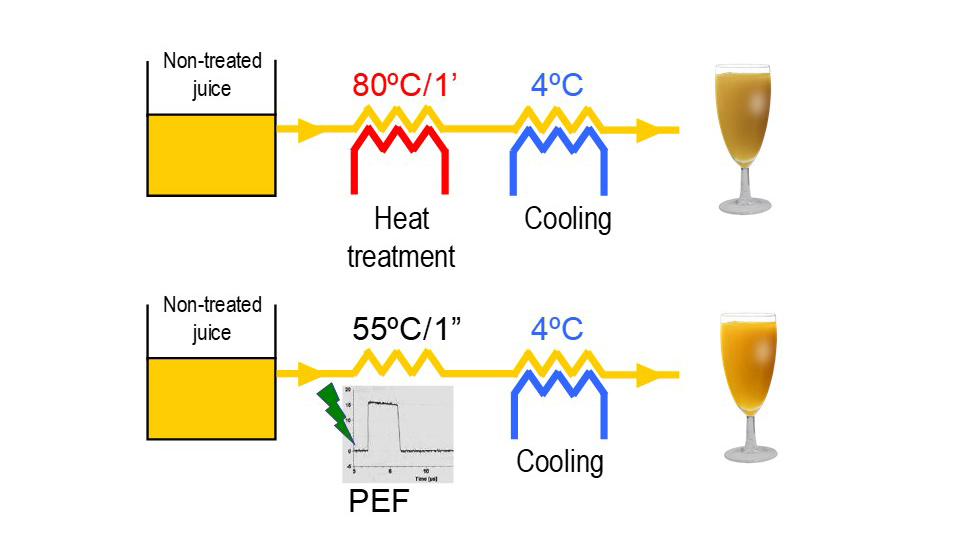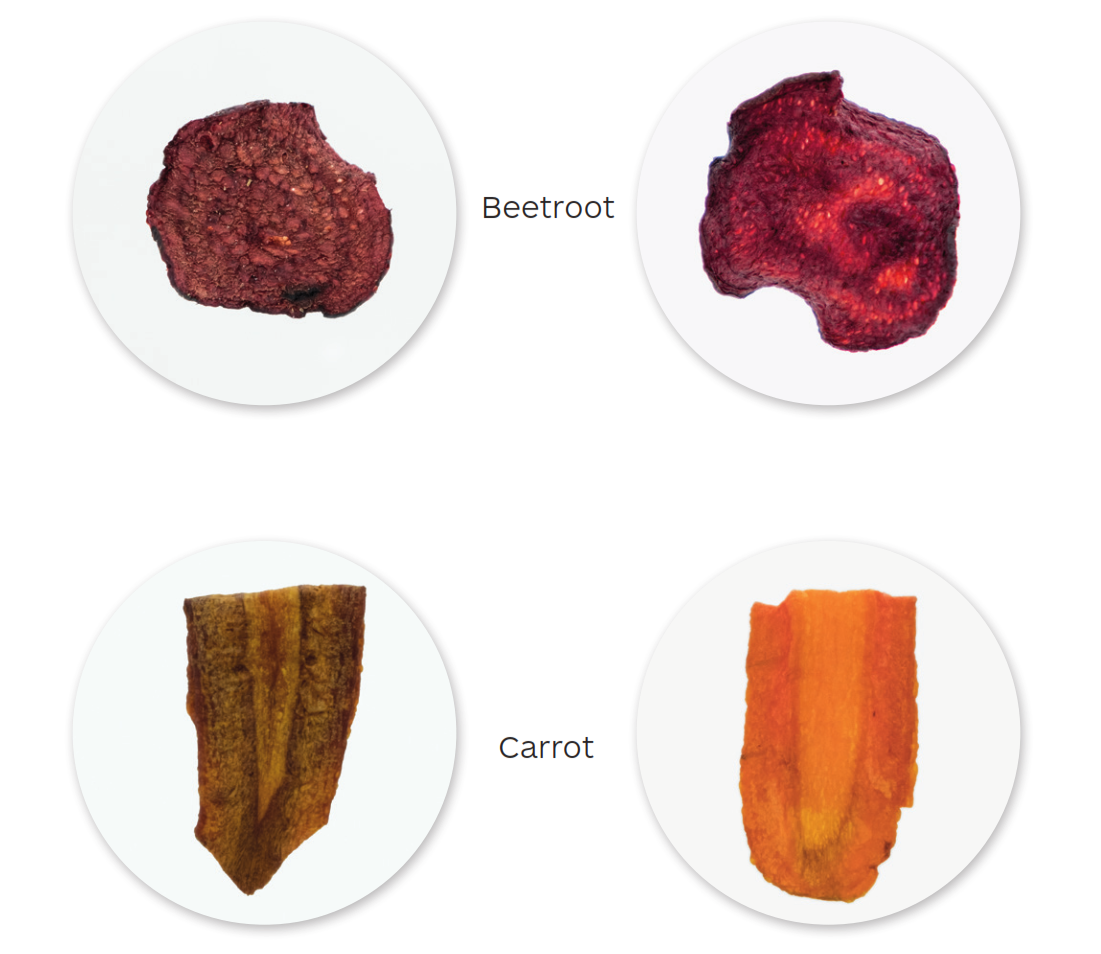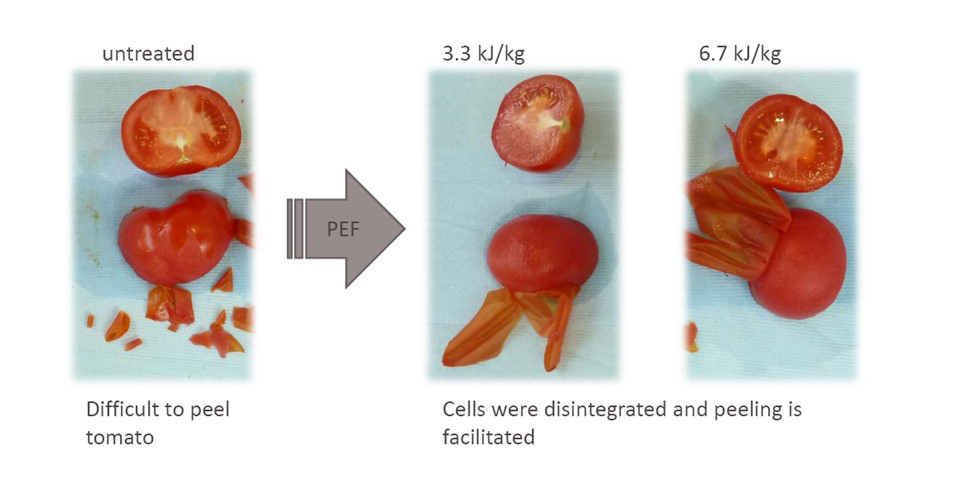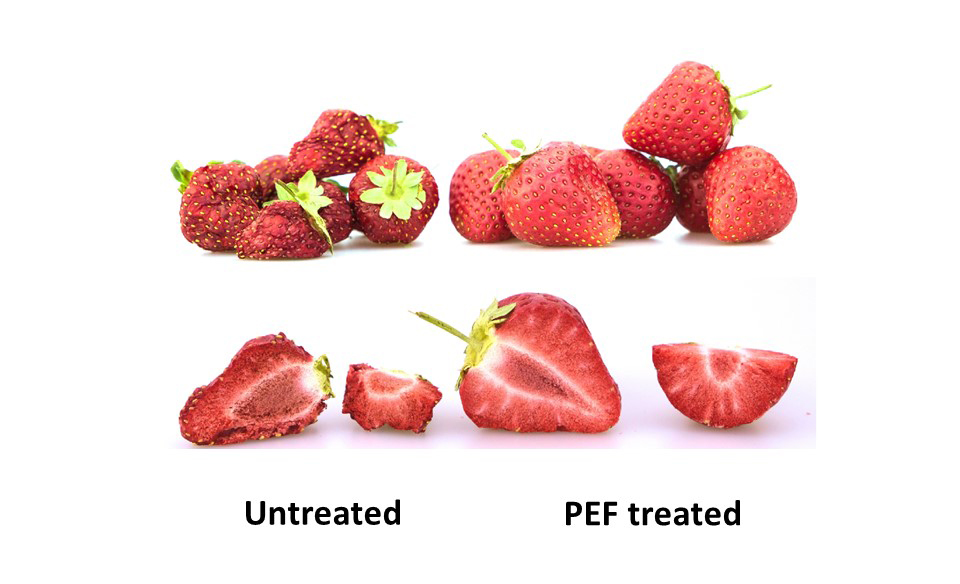Pulsed electric fields (PEF) is one of the most promising non-thermal technologies as a gentle method of food preservation.
What is PEF?
When food is exposed to pulsed electric fields (PEF), pores form in the cell membrane of the product being treated. Depending on the pulse frequency and electric field strength, pores form in pathogen cells so that they are inactivated, or pores form in the cells of the food product, to give them favourable properties.
The pores in the cell membranes make it easier for molecules to enter or exit from cells. Therefore this method has a number of applications in the food industry, such as for the extraction of components, the improvement of drying processes, and texture modification.
Watch video: How PEF works for food industry
Applications in the food industry
Food preservation
PEF is capable of inactivating pathogenic and spoilage bacteria, although not spores or enzymes, while preserving the sensorial and nutritive properties of food products. Therefore it can be used as a method for pasteurisation or shelf life extension of liquid food products, especially acidic products in which spores will not be able to germinate. Therefore, one of the most relevant applications of PEF is the pasteurisation (in continuous mode) of fruit juices, although studies involving many other food products, such as milks, egg and vegetable products, have also been conducted.

Given the relatively high energetic requirements if used alone, PEF is typically used for food preservation in combination with other agents, especially with mild heat. Due to its synergism with mild heat, most industrial PEF lines in the juice industry make use of existing or tailored pre-heating and cooling setups, operating at inlet temperatures ranging from 30 to 40 °C and maximum product temperatures far below 60 °C. The combined approach also allows for recovery of the electrical energy applied and optimum energy efficiency.
Extraction of components of interest

Given its ability to generate pores (permeabilisation) in cellular membranes, PEF is a very useful technology for the gentle extraction (low energetic cost, no chemicals needed, high selectivity) of components of interest from animal, vegetable, algae, fungi and microbial cells/tissues.
Thus, its potential to improve the extraction process of very specific components, such as chlorophyll, carotenoids, polyphenols, luteins and even proteins (dehydrogenases, kinases, β-d-galactosidase, etc.), from various sources has been widely demonstrated, and the potential to improve processes in which the extraction of intracellular components is the key process, such as wine (extraction of antioxidants and pigments) or olive oil production, has also been proved up to the industrial level. Furthermore, PEF can also be used as a pre-treatment in some processes, such as juice production, in order to improve the yields.
Improving drying processes
Permeabilisation of membranes can also facilitate the drying process of food (vegetable and meat) products, which is a method that has long been used to inhibit microbial growth and to thereby preserve food. In these processes, the application of PEF would not only help to reduce drying time (by up to 20 %, on average) and prevent core crust formation and shrinkage, but would also help to reduce drying temperature, so less-detrimental effects on product colour, shape and taste are induced during the drying process. Drying time and temperature reduction will also help to reduce the energetic cost associated with the process.

It should also be noted that PEF treatments can improve any kind of drying technology/process: from conventional air drying to vacuum, freeze or osmotic drying.
Textural modification of vegetable foods
Electroporation of plant cells can cause different effects, besides the increase in the rate of entry and exit of compounds. One of these is the change in peel attachment. This phenomenon can be used, for instance, for improving tomato peeling (Image 7). Exposure to PEF increases the amount of water under the tomato skin, which is vaporised when the PEF-treated tomatoes are heated (steamed).

This PEF treatment improves the efficiency of the overall process and the quality of the product, as well as reducing water and energy requirements. Thus, compared to conventional steam processing, the steam pressure, energy consumption and peeling time are reduced by about 20–30 %.
Another very interesting modification induced by PEF in vegetable tissues is their softening, which facilitates their cutting. The application of PEF treatments also makes vegetable tissue more flexible. This is very interesting, for instance, for nuts and seeds, such as cashews, since increased elasticity causes less breakage during shelling and better kernel integrity.

Similarly, it also helps to reduce the breakage of (frozen) French fries during storage and transport. Regarding this latter product, the application of PEF also provides some other advantages such as a better crunch and colour, a lower amount of oil in the final product, the enabling of the application of lower temperatures during frying, so a lower amount of acrylamide is produced, and helping to save up to 90 % of water and energy consumption, as compared to standard processing. Similar advantages are obtained when carrot, parsnip or beetroot chips are produced.
Improvement of other processes in the meat industry
Besides meat drying, the application of PEF can also help to improve other processes commonly used in the meat (and fish) industry, such as brining and tumbling. On the other hand, the use of PEF for meat tenderisation is still under research, with contradictory findings reported to date, probably due to the complexity of this process.
Volumetric heating
Although PEF has traditionally been used as a non-thermal technique, the application of a voltage between two electrodes separated by the product to be treated leads to the passage of an electrical current that induces ohmic heating of the product by Joule effect. Thus, increasing the field strength and/or the treatment time (including pulse width and frequency, considered within the time parameter) increases the energy transferred to the treated medium, thereby increasing the temperature reached after the treatment.
This fact opens up the possibility of using PEF as a high-capacity heating system for microbial inactivation and blanching, similarly to microwaves or radio frequency, but with a higher penetration capacity in the product, and attaining an energetic efficiency close to 90 %. Moreover, the electropermeabilising effect of PEF would allow for an increase in the electrical conductivity of the product, thereby augmenting energy transfer while pulsing, and enabling a greater uniformity along the whole product, particularly if solid products are treated.
| Title | Author(s) | Year | |
|---|---|---|---|
| Pulsed Electric Field-assisted extraction of valuable compounds from microorganisms | Martínez, JM, Delso, C, Álvarez, I, Raso, J. | 2020 | Go to publication |
| Applications of pulsed electric field treatments for the enhancement of mass transfer from vegetable tissue | Donsì F, Ferrari G, Pataro G. | 2010 | Go to publication |
| Microbiological aspects related to the feasibility of PEF technology for food pasteurization | Saldaña, G.; Álvarez, I.; Condón, S.; Raso, J. | 2014 | Go to publication |


